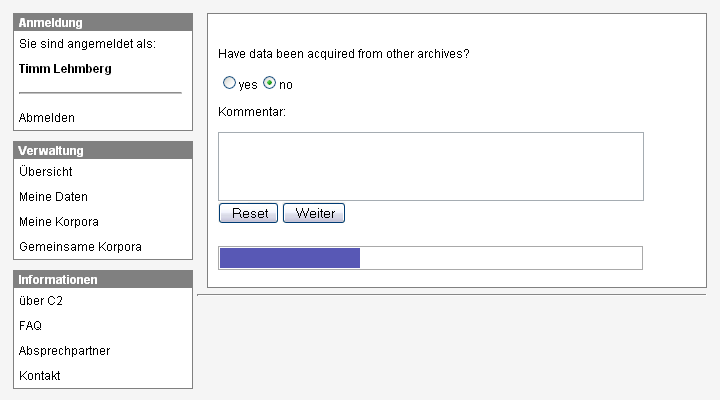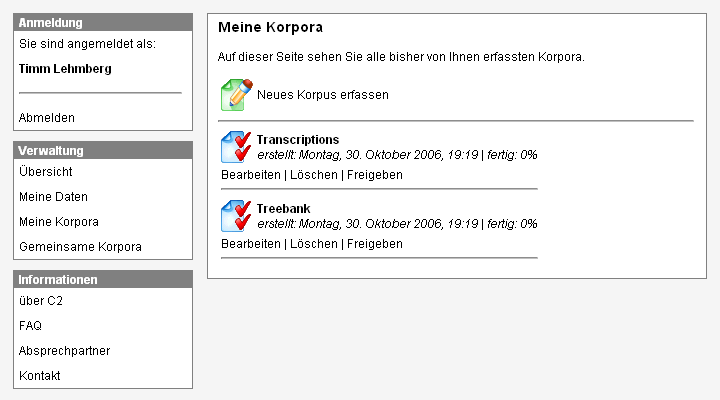Collecting Legally Relevant Metadata by Means of a Decision-Tree-Based Questionnaire System
Timm Lehmberg1, Christian Chiarcos2,
Erhard Hinrichs3, Georg Rehm3, Andreas Witt3
Project C2: Sustainability of Linguistic Data
Hamburg University – SFB 538: Multilingualism1
Max-Brauer-Allee 60, 22765 Hamburg, Germany
Potsdam University – SFB 632: Information Structure2
Karl-Liebknecht-Straße 24-25, 14476 Golm, Germany
Tübingen University – SFB 441: Linguistic Data Structures3
Nauklerstraße 35, 72074 Tübingen, Germany
Corresponding author: timm.lehmberg@uni-hamburg.de
1 Introduction and Overall Concept
Most metadata standards used for corpus linguistic purposes (TEI, OLAC, IMDI
etc., for a complete overview see Lehmberg and Wörner 2007 [2]) require elements that contain legal
information about the rights holder to the particular resource and/or its
accessibility. Normally these metadata elements are kept very abstract and do
neither distinguish between the different types of personal rights nor do they
consider the option of multiple holders of copyright.
The legal situation upon which the evaluation of linguistic data to be used
for scientific purposes is based is clearly defined, but too complex to be
understood completely by non-experts. Furthermore, it varies from one country
to the other and is in a constant state of flux.
In the framework of our joint sustainability
initiative (see the introduction to this session), a large number of
heterogeneous corpora have been acquired from multiple sources and multiple
projects, and processed with regard to different individual requirements
(Schmidt et al. 2006 [3]). This
heterogeneity is responsible for the problem that the legal metadata that need
to be collected strongly vary with regard to the respective corpus and data
situation. Only for a small number of projects associated with our
sustainability initiative are detailed sets of legal metadata that inform a
potential user of the corpus about, for example, stipulations or copyright
holders, readily available. For the majority of projects and corpora, this
task has to be performed retroactively.
 Figure 1: A concept map visualising the query structure
Facing the complexity of the legal context (see Zimmermann and Lehmberg, in
this session), it is almost impossible for non-experts to evaluate the
situation of their language data and to extract the relevant metadata without
professional advice.
To reduce the complexity of this task, concept maps were created with the goal
of making the legal situation as well as the legal terminology transparent and
understandable to non-professionals. Unlike mindmaps that are primarily used
for the (often spontaneous and intuitive) mapping of ideas and processes, the
technique of concept mapping is intended more for knowledge modelling:
concepts are represented by nodes, links represent the relations between them.
As a utility to create the concept maps modelling the legal situation within
our joint sustainability initiative we used CmapTools, a program
distributed by the Institute for Human and Machine Cognition (IHMC).
IHMC CmapTools provide a client/server architecture that allows
users at different locations to work collectively on Concept Maps and to
discuss their structure and content online.
Based on these schemata and following the principles of decision-trees, we
built an additional concept map representing the query structure of a
questionnaire. Digressing from the original principles of concept mapping
mentioned above, in this map queries are represented as nodes whereas
responses are represented as links between them. The primary query given in
the centre node (see figure 1) corresponds to two central aspects of
law (data protection and copyright, see Zimmermann and Lehmberg, in this
session). Each response leads to a large number of additional queries that
again, depending on the users' response, have subordinated queries. Further
sections of the concept map deal with the accessibility of the data as well as
their respective principles and standards of data processing.
In same manner we modelled the query structure that surveys the meta
information that ideally has been collected in connection with the compilation
process of corpora. Therefore it contains queries asking for established
metadata standards (TEI, DC, OLAC, IMDI etc.) that may have been
used, and if necessary asks for additional information.
Due to the fact that the IHMC CmapTools provide an export of concept maps into
an XML-based format, the content and structure of the concept map can be
processed automatically to create the web based questionnaire that is
described in the following section.
The complete concept map structures will be demonstrated in conjunction with
example scenarios in our presentation.
Figure 1: A concept map visualising the query structure
Facing the complexity of the legal context (see Zimmermann and Lehmberg, in
this session), it is almost impossible for non-experts to evaluate the
situation of their language data and to extract the relevant metadata without
professional advice.
To reduce the complexity of this task, concept maps were created with the goal
of making the legal situation as well as the legal terminology transparent and
understandable to non-professionals. Unlike mindmaps that are primarily used
for the (often spontaneous and intuitive) mapping of ideas and processes, the
technique of concept mapping is intended more for knowledge modelling:
concepts are represented by nodes, links represent the relations between them.
As a utility to create the concept maps modelling the legal situation within
our joint sustainability initiative we used CmapTools, a program
distributed by the Institute for Human and Machine Cognition (IHMC).
IHMC CmapTools provide a client/server architecture that allows
users at different locations to work collectively on Concept Maps and to
discuss their structure and content online.
Based on these schemata and following the principles of decision-trees, we
built an additional concept map representing the query structure of a
questionnaire. Digressing from the original principles of concept mapping
mentioned above, in this map queries are represented as nodes whereas
responses are represented as links between them. The primary query given in
the centre node (see figure 1) corresponds to two central aspects of
law (data protection and copyright, see Zimmermann and Lehmberg, in this
session). Each response leads to a large number of additional queries that
again, depending on the users' response, have subordinated queries. Further
sections of the concept map deal with the accessibility of the data as well as
their respective principles and standards of data processing.
In same manner we modelled the query structure that surveys the meta
information that ideally has been collected in connection with the compilation
process of corpora. Therefore it contains queries asking for established
metadata standards (TEI, DC, OLAC, IMDI etc.) that may have been
used, and if necessary asks for additional information.
Due to the fact that the IHMC CmapTools provide an export of concept maps into
an XML-based format, the content and structure of the concept map can be
processed automatically to create the web based questionnaire that is
described in the following section.
The complete concept map structures will be demonstrated in conjunction with
example scenarios in our presentation.
2 Implementation
As the questionnaire has to be accessible from different research project
locations, it has been implemented using a XAMP (any operating system, Apache,
MySQL and PHP) architecture to create a user-friendly, web-based interface.
The conceptual structure represented by the concept map is transformed into a
relational database model. Accordingly, it is possible both to model the tree
structure of the queries [1] and to
save responses to these questions within the database. Additionally, the
database includes user data (as well as user access control data) and links
them to the metadata sets of the resource being acquired by the questionnaire.
 Figure 2: A web-based wizard guides the user through the questionnaire
The user interface is generated by a script that parses the database and
guides the user though the questionnaire tree with the help of a web-based
wizard (see figure 2). This architecture has several advantages:
Figure 2: A web-based wizard guides the user through the questionnaire
The user interface is generated by a script that parses the database and
guides the user though the questionnaire tree with the help of a web-based
wizard (see figure 2). This architecture has several advantages:
 Figure 3: An overview page gives information about the data collection
progress
Figure 3: An overview page gives information about the data collection
progress
- Subordinate queries that refer to specific details of some legal aspects
automatically can be skipped if they become superfluous. For instance, there
is no need to query contractual agreements with subjects if there is no
personal data contained in the corpus.
- The data model provides users with the option of registering multiple
corpora and running the questionnaire wizard individually. Furthermore,
users can share the data they entered into the system with other registered
users so that it is possible to edit the data across project locations (for
example, queries can be skipped, answered later, or left to other users).
- Should the structure or content of the questionnaire tree be changed,
the database will be modified accordingly. If the change leads to unanswered
queries, this will be indicated to the user in a status page. For this
reason, every user account has an overview page that gives information about
the state of progress of every registered resource (see
figure 3).
- The questionnaire includes queries about metadata content and standards
that already have been applied to the registered corpora, so that users do
not have to insert redundant information already contained in existing
metadata sets.
- Administrator users have unlimited access to all data in the database,
so that users can be provided with support, if needed.
We are currently in the process of collecting legally relevant
metadata from about 60 different research projects with the aid of the
questionnaire system described in this paper. Content and structure of the
concept maps is available on our project homepage at
/sfb441/c2/.
References
- [1]
-
Joe Celko.
Trees and Hierarchies in SQL for Smarties.
Morgan Kaufmann, San Mateo, 2004.
- [2]
-
Timm Lehmberg and Kai Wörner.
Annotation Standards.
In Anke Lüdeling and Merja Kytö, editors, Corpus
Linguistics, Handbücher zur Sprach- und Kommunikationswissenschaft
(HSK). de Gruyter, Berlin, New York, 2007.
In press.
- [3]
-
Thomas Schmidt, Christian Chiarcos, Timm Lehmberg, Georg Rehm, Andreas Witt,
and Erhard Hinrichs.
Avoiding Data Graveyards: From Heterogeneous Data
Collected in Multiple Research Projects to Sustainable Linguistic
Resources.
In Proceedings of the E-MELD 2006 Workshop on Digital
Language Documentation: Tools and Standards – The State of the Art, East
Lansing, Michigan, June 2006.



